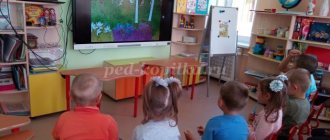Literature:
1. Avdeeva N.N., Meshcheryakova S.Yu., Razhnikov V.G. Psychology of your baby. – M., AST Publishing House, 1996. – 384 p.
2. Diagnosis of speech disorders in children and organization of speech therapy work in a preschool educational institution: Sat. methodological recommendations. – 240. – St. Petersburg: DETSTVO-PRESS, 2001.
3. Gribova O.E. What to do if your child does not speak. – M.: Iris-press, 2004.
4. Fomicheva M.F. Education of correct pronunciation in children. – M.: Education, 1989.
How does a preschooler express himself?
Before you begin speech development exercises, you need to understand that speech itself is characterized by various features and is divided into several types according to these features.
When communicating with family and loved ones at this age, the child most often describes a specific situation or asks questions directly related to what he sees around him. The speech of a preschooler that fully describes the situation is called situational.
Preschool age
Situational speech
Situational speech is speech that a child uses in a certain situation to describe what is happening around him or to ask questions that require clarification.
The main beacon of situational speech is the replacement of the subject with a pronoun. At such moments, it can be quite difficult for adults to follow the child’s train of thought and determine what is being said. Along with the chaotic use of pronouns, the diversity of adverbs, which also do not add specificity, is also confusing. However, over time, when thinking begins to develop with renewed vigor, nouns appear instead of endless pronouns. Feeling that he is talking to an interlocutor and must convey his thoughts in a way that the other person can understand, the child after the pronoun puts the name of the object he is talking about.
Note! Thus, the outline of the story is each time interrupted by new details about the subject being described, and questions from the listener only fuel interest and the desire to tell further.
Contextual speech
New strangers and ever-growing curiosity help master contextual speech. Gradually moving from describing specific situations to abstract ones, the child learns to describe what happened to him earlier. Unlike situational speech, which is understandable only at the moment of what is happening, contextual speech is used to explain that the issues that concern him have already been resolved, and to talk about how this happened.
Moreover, it does not replace situational speech, but comes to its aid, and the further development of both types of speech occurs simultaneously.
Explanatory speech
Communication with peers in older preschool age often requires the transmission of game instructions or manipulations with toys. The speech of a preschooler containing instructions, explanations, directions is called explanatory.
Explanatory speech of a child
Features of pre-speech communication.
It is no longer news to anyone that from birth a baby is able to distinguish human speech from all surrounding sounds. Moreover, he synchronizes his motor activity with the rhythm of the adult’s meaningful speech. Already during pregnancy, the child is able to hear and remember the mother’s speech. If she regularly reads the same poem aloud, then when she hears it after birth, the baby reacts specifically to this poem, distinguishes it from others (which manifests itself in a change in the rhythm of sucking the pacifier).
In other words, a child is naturally endowed with the ability to develop speech. Adults must create conditions conducive to this development. There are different ones for every age. At the newborn stage, it is enough for the baby to hear the speech of an adult. It plays a major role in the development of auditory concentration.
When compared with other influences, the maximum attention and joy of a newborn is caused by speech addressed to him, since this is the most obvious sign that an adult is entering into communication. Moreover, the baby shows special sensitivity to special “baby speech”, which is also, apparently, not accidental, because only a loving mother, filled with tenderness, when addressing the baby, begins to speak in a thin “lisping” voice. And a child at this age needs affection, tenderness, and love most of all. Of course, for lack of anything better, the baby will begin to react to ordinary, “adult” speech (nature has taken care of such cases as well).
56 pages, 27646 words
Development of speech in children of senior preschool age by means of...
... science, the features of the development of speech of older preschool children and the influence of small forms of folklore on the development of speech of children of older preschool age are analyzed. In the second chapter, “Content and methodology for the development of children’s speech using ... in our time, due to difficult social conditions, due to busyness, people often forget about this and the process of developing their child’s speech is left to chance. The child spends more time ...
But can we be sure that the child will receive everything he needs, and will his reserves remain unexhausted? Isn’t the ability to address a child in such a special way connected with the innermost feelings that the mother experiences for the baby?
You already know that in the first half of the year, on the basis of mutual expressions of love, the first attachments are formed, the ability to openly and fully express one’s feelings. They probably form later, but one should hardly miss the opportunity for the timely appearance of something that will require special additional efforts at a later age.
Although in the first half of life the child himself does not yet master the elements of speech, he is undergoing intensive formation. speech hearing. The baby needs to hear an adult, but not just a speaker and not just people among themselves, but speech addressed directly to him. Only in this case will it have adequate significance for the infant’s speech development. And on the contrary, if a child constantly turns on the radio instead of live human communication, then interest in speech fades away.
Psychologists have determined how children aged 3 to 10 months react to the sounds of the human voice and musical instruments. In the first half of the year, children react in a special way to melodic, intonation sounds of the voice precisely because a person always includes sound influences of this kind in his communication with babies: At the end of this half of the year, emotional reactions to the sounds of a musical instrument intensify, as the content of the child’s communication begins to change with adults, which includes various objects, including voiced ones. In the second half of the year, children already clearly distinguish all vocal influences and selectively respond to speech sounds. At this age, speech analysis becomes a condition for maintaining and implementing situational business communication.
In the laboratory of the mental development of preschool children at the Research Institute of General and Pedagogical Psychology, a series of studies was conducted on the processes of child speech development. Scientists have found that speech develops primarily as a means of communication. In order for a child to speak on time, the correct and timely development of communication itself is necessary. This is why the first year of a child’s life is so important. In the first half of the year, emotional contacts with an adult help children identify the adult’s speech as a distinctive feature of his addresses to the baby. Attachment to an adult gives rise to a desire in children to imitate him; a trusting attitude towards an adult encourages children to turn to him to share their experiences and difficulties.
It is not for nothing that children raised in families begin to speak earlier than those in an orphanage. Despite intensive training with speech therapists, children rarely use speech, and speech itself is extremely poor in composition and intonation. This is understandable, because in the conditions of a children’s home, children’s communication with adults is very poor, it mainly comes down to children following the adult’s commands, and the constant transition from group to group deprives children of the opportunity to establish deep attachments.
If in the first half of life a child identifies the speech of an adult as a distinctive feature of his addresses, regardless of the meaning of the statements, then in the second half of the year he masters the understanding of speech, without which the implementation of business communication is not possible. The teachers conducted such an experiment. They addressed children during the first year of life with affectionate and angry words (expressing reproach or unpleasant surprise).
3 pages, 1354 words
Organization of correctional and developmental work with children (I level of speech development)
... focus on a well-known situation, intonation and facial expressions of an adult. This allows them to compensate for the insufficient development of the impressive side of speech. In independent speech... Therefore, the child is forced to actively use paralinguistic means of communication: gestures, facial expressions, intonation. When perceiving addressed speech, children...
In the first half of the year, children responded to all requests with joyful smiles. In the second half of the year, they already clearly distinguished between positive and negative meanings: they accepted affectionate addresses calmly or with a smile and expressed dissatisfaction, resentment or aggression when reproached and blamed.
The transition to the stage of situational business communication not only requires the child to understand the adult’s speech, but also encourages him to name objects, indicate actions, and call on the adult using words. The child begins to babble. By pronouncing the sounds made by the child, the adult encourages him to repeat them again and again, thereby practicing correct articulation. The child looks at the adult’s lips, touches them, even tries to get into his mouth. This is very important for studying the functioning of the speech organs.
How can you judge that a child’s pre-speech development is proceeding correctly? In the first half of life, if the baby makes sounds (booming, humming), accompanied by joyful animation, the development of communication proceeds normally. However, there is evidence that both deaf and mentally retarded children vocalize in the first half of life. If the child does not make sounds, then this indicates serious defects either in the speech apparatus or in the central nervous system. In the second half of life, the presence of babbling is more indicative of the diagnosis of speech development than the first vocalizations in the previous half of the year. If the baby does not babble, then this should alert parents and serve as a reason for a visit to specialists. From birth, a process of pre-speech development, hidden from superficial observation, occurs, which occurs when communicating with an adult.
How to quickly develop the speech of a primary school student
If your child is already a junior in school, and he still constructs sentences clumsily, finds it difficult to express his thoughts, cannot write summaries and essays, and retells them poorly, then you need to sound the alarm. But it is advisable not to force the child to do something, but to interest him.
To do this, I compiled a workbook, which in the hands of a child turns into his creation - a self-written book with stories of his own composition.
All children love to dream and fantasize. This is inherent in them by nature itself. If this talent has not yet manifested itself in a little person, then it needs to be illuminated so that it shines with all the rainbow colors.
Nowadays it is very difficult to be successful without developed speech. And every parent wants his child to stand on his own two feet and achieve a lot in life. This will largely be facilitated by confident speech, creative thinking, a flexible mind and competent writing.
The “I Can Compose” workbook activities address these challenges.
The notebook can be used both individually for creative work at home and in the classroom by a teacher.
These tasks will serve as a good help for lessons on the development of students' speech. Children will learn not only to fantasize and think figuratively, but also to construct sentences beautifully and correctly format them in writing. After these exercises, it will be much easier for children to write essays and presentations.
The notebook can be used in different ways.
This can be individual work throughout the year with periodic exchange and reading of each other's work by classmates. Children love this very much, and at the same time they are fully involved in the process and grasp the necessary skills on the fly. It is advisable to reward the most successful works with positive assessments. You can organize work in pairs or groups. Which also arouses considerable interest and brings children closer together.
As a result, each child will have a whole book written by him with interesting stories, and at the same time a developed imagination and more confident literate speech.
The workbook contains 22 tasks for composing stories on a given topic, and there are also pages for free creativity, which, if desired, you can always print out more.
As practice shows, children who have undeveloped speech also read poorly. Therefore, it is advisable to combine speech development classes with exercises to increase the quality and speed of reading. Training with specially written texts and exercises is perfect for this.
The books are written in such a way that you can study them without being a professional. That is, every parent, if desired, can become a good tutor for their child. And if you are a teacher, then these developments will be a good help in your work.
Dynamics of speech formation
As you know, timely and complete mastery of speech is an important condition for the development of a child’s personality. The process of speech formation covers several age stages.
Particularly productive and important in this regard is the period of early and junior preschool age from 0.8-1 year to 3-4 years. During this short period of time, the child masters the basic laws of language. By the age of 3-4 years, his vocabulary consists of approximately 800-1000 words, while the child practically does not use onomatopoeia and lightweight versions of words. He knows how to construct basic types of sentences in compliance with grammatical rules. A four-year-old child can retell the content of a simple fairy tale, talk about his actions, and analyze his everyday situation.
This period is described in most detail, stage by stage, by specialists in the field of children's speech. Next, I will give a table that gives the sequence of appearance of certain phenomena in children's speech and indicates the age standards for their appearance. This time is not strictly obligatory; the timing and, to some extent, the sequence of development of speech forms can vary in accordance with the individual characteristics and gender of the child. The table provides average statistical data on the time frame during which certain forms of communication and linguistic units may appear in accordance with the norm of development. These periods can be quite extended, which is explained by the individual developmental characteristics of the child. However, if during a certain period the indicated forms do not appear, or you see isolated manifestations, this should alert you.
Dynamics of speech formation in ontogenesis
| № | Form of speech | Approximate age of appearance |
| 1. | Intonates screams. (You can distinguish between cries of pleasure and displeasure) | 1-2 months |
| 2. | Hooting, humming. (The child repeats after you or independently pronounces individual syllables, as if he is playing with them) | 1.5-3 months. |
| 3. | Babble. (The child repeats after you and himself says something similar to words, but consisting of the same syllables) | 4-5 months |
| 4. | Babbling words (The child uses “nanny language” in speech; words consist of two or three open syllables (lyalya, tata, kuka, etc.), a lot of onomatopoeia (beep-beep, woof-woof, pee-pee, etc.) | 8 months - 1 year 2 months |
| 5. | Two word sentences. (The child, when communicating with you, combines two words, for example: give pi (give me a drink), papa no (dad is not at home), etc.) | 1 year 6 months -2 years 2 months |
| 6. | Active growth of vocabulary (Child asks what it is called) | 1 year 9 months - 2 years 6 months |
| 7. | The appearance of grammatical forms of words (The child changes words in speech according to numbers, gender, cases, etc.) | 2 years 4 months - 3 years 6 months |
| 88. | Word creation (The child composes his own words, but at the same time uses the laws of his native language) | 2 years 6 months – 3 years 5 months. |
| 99. | The child actively communicates with adults he knows well | 1 -1.5 years |
| The child speaks out his actions when he is alone playing with toys or doing something else. | 2 years 6 months -3 years 6 months. |
It is known that the speech development of boys and girls is somewhat unique. Girls tend to start speaking earlier. Their vocabulary of words denoting objects is rapidly growing. Girls master phrasal speech relatively late, but they try to speak correctly, “like adults.” Boys' speech is characterized by a later onset. First of all, they develop a vocabulary of names of actions; a grammatical structure is formed relatively early, but boys often speak “in their own language.”
The same situation is described differently by boys and girls. For example, a child wants a ball. Most likely, the boy will loudly shout: “Give me!”, and the girl will quietly whine: “Ball!” For parents the difference is small, but for a specialist it is significant.
How to develop speech in children?
Remember: developed and competent speech is the key to your child’s success. This issue needs to be approached multifacetedly, seriously and in a timely manner. This will help you:
- pure talk;
- Tongue Twisters;
- puzzles;
- charades;
- word formation games;
- rhyming exercises;
- compiling syncwines.
Follow the links. Each article provides comprehensive material that will contribute to the development of your child’s speech. Remember that without the active help of an adult, a modern child is unlikely to speak well and fluently. Therefore, develop your child’s speech and thinking.
Signs of successful speech development
• The child's physical development is appropriate for his age.
• The child does not have any neurological diseases.
• The child actively communicates with friends and family and is embarrassed to talk to strangers.
• The child willingly repeats after you everything he hears.
• The child actively solves his problems through speech.
• The child listens to his own speech and tries to correct his mistakes himself.
Signs of poor speech development in a child
• The child develops with delay.
• The child suffered serious illnesses.
The child has neurological diseases.
The child is reluctant to repeat after you the words and sentences that he hears.
When a child hears the request “Repeat” or “Say that again,” he remains silent, gritting his teeth, or walks away as if he did not hear you.
He prefers to solve all his problems on his own, without turning to you for help.
The child communicates equally actively with adults and strangers.
The child does not care whether anyone understands him. He speaks one language that he understands. He doesn’t respond to comments like “Say it again better.”
The child’s speech lags significantly behind the level of speech development of his peers.
Why develop speech in children?
If at this stage of speech development everything is in order, then you should think about the development of the child’s coherent speech. After all, developed speech can affect the success of a child and his further implementation in life.
When a child speaks, he:
- thinks;
- analyzes;
- compares;
- his logical thinking develops.
In communication, primarily with parents, children adopt the manner of speaking and expressing thoughts, the pace of speech, and actively replenish their vocabulary.
Gradually, over time, it becomes easy for the child to express his thoughts, communicate with peers, contact adults, share his impressions and, subsequently, it is easier for him to learn.
The child becomes more self-confident and begins to take leadership positions.
A child with undeveloped speech cannot fully analyze and classify his impressions, make generalizations and conclusions about the world around him. The main thing is that the child himself begins to realize that it is difficult for him to express his thoughts. Such children, as a rule, become irritable, may withdraw into themselves or begin to be embarrassed to communicate with children and adults, avoid playing together, and be afraid that they will laugh at them.
It is not without reason that most parents and specialists: doctors, speech pathologists, speech therapists, teachers, and psychologists attach such importance to the development of children’s speech.






